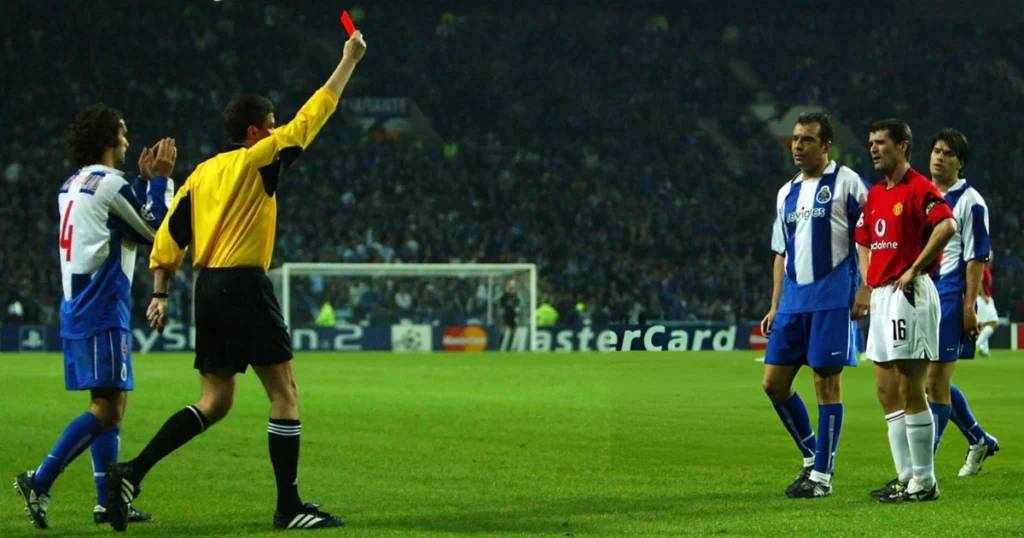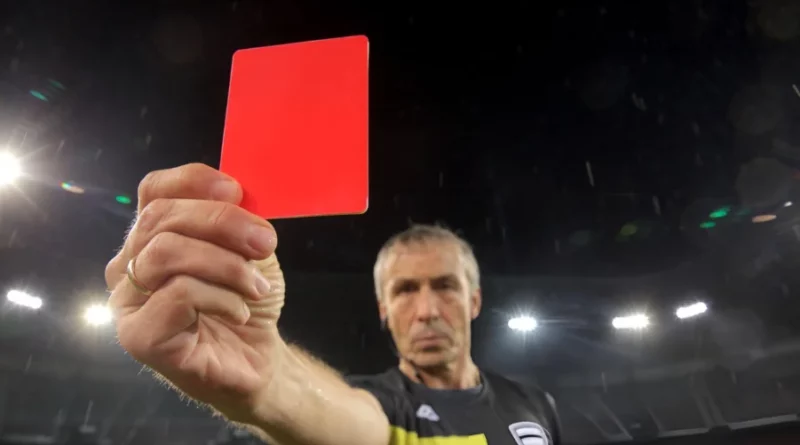Red card in soccer: Everything to know about it
A red card in soccer is a punishment dished out to a player for multiple reasons. It could be for fouls, violent conduct, and many other reasons. It is seen as a big disappointment for the player and the team and a player must look to avoid it.
Over the years, we have seen some players have bad reputations in regards to their red-card count. The likes of Sergio Ramos, Roy Keane, etc. built a reputation for collecting these cards despite being such legendary players. On the other hand, there are players like Phillip Lahm, who barely even got a yellow card.
On that note, let’s take a look at what a red card in soccer really means.
Also Read: Top Most Popular and Widely Used Soccer Formations
Red card meaning in soccer

While soccer is mostly played in good spirits and for entertainment, the pressure, adrenaline, or just mistakes can lead to some discipline issues in a match. Hence, they have officials to keep such things in check during a match.
To keep players, managers, and the staff in check, the officials are bestowed with some powers, including cards. Referees can start with something as basic as talking to a player if they’ve made a simple foul. However, if it continues or the foul is a serious offense, they can give out cards to the players.
A red card is the biggest card a player can receive, which results in them getting sent off straight away. They have to leave the field of play, leaving their team short of a player for the remainder of the match. It puts their team at a big disadvantage as they are left to play the remainder of the match 10 vs 11. It doesn’t end there though as more than one player of one team can be sent off in a single match.
Receiving a red card

A player can receive a red card directly or two yellow cards in the same game, which also results in a red card.
Depending upon the nature of their offense, the said player is not only suspended from the ongoing match but also from future matches. A red card which is received after two yellow cards generally results in a one-match ban from the following game. A red card for violent conduct can lead to a three-match ban at least, if not more. A red card for a tactical foul can lead to a one-match ban.
These bans are applied to all competitions under the banner. For example, a player receiving a three-match ban after a red card in a Premier League game will also be banned for the Carabao Cup and the FA Cup. However, their suspension won’t apply to European competitions like the UEFA Champions League, Europa League, etc.
Regardless, it’s a big disadvantage to a team. Most of the time, a manager makes a substitution after a player is sent off to try to balance their side. It’s mainly in the case when a defensive player or a goalkeeper is sent off.
However, in some scenarios, a player can be sent off when the manager has already completed all of their allowed substitutions. If this happens in the case of a goalkeeper, an outfield player might have to step up and don the gloves for the remainder of the match. The likes of Harry Kane and Dani Alves have also done it in the past.
Also Read: What is a soccer pitch?
Offenses that can lead to a red card
Now that we know how detrimental a red card can be for a player and their team, let’s take a look at what exactly leads to a referee branding a red card in a match.
There are multiple instances when a player can receive a red card. They are as follows:
- Serious foul play
- Violent conduct like headbutt, trying to injure an opponent, etc.
- Spitting on a player/official
- Abusive language
- Denying a clear goalscoring opportunity by either fouling a player or using hands (except goalkeeper)
- Making a foul being the last man between the player and the goalkeeper/goal, which also comes under denying a clear goalscoring opportunity.
As aforementioned, a player also gets a red card when they receive their second yellow card in the same match. It could again be for any of the above-listed reasons but at a lower intensity.
Standard foul rules apply when a player is sent off though. The match is restarted from the spot where the foul occurred in the form of a free-kick for the opposition team. If the foul took place inside the penalty area, the match is restarted with a penalty kick for the opposition.
Origin of the red card in soccer
The idea of the yellow and red cards was first introduced after the 1970 FIFA World Cup. When the referee sent off Italy’s Georgio Ferrini in 1962, he refused to leave the pitch. Hence, there was a need for clear indicators for such punishments.
The idea of yellow and red cards came about in 1970. In England, meanwhile, it was first used in 1976. It had to face backlash at the start and it was even abolished. However, the system was eventually brought back in 1987 as the English FA remained in line with the rest of the world.
FAQs
Q. What happens if you get a red card in soccer?
A. When a player receives a red card, they are sent off right there. They cannot take further in the match and their team has to play the remainder of the match with one player less. The player also suffers a further ban.
Q. How long does a red card last?
A. It depends on the kind of offence. For tactical fouls, handballs or two yellow cards, a player is banned for one match. For serious offence, they are banned for three games. Sometimes, they can even be banned for more games if the offence is grave.
Q. How many games do you miss if you get a red card?
A. It depends on the offence. It generally lasts between 1-3 games but could be more.
Also Read: Understanding Soccer Positions: A Full Breakdown and Explanation
